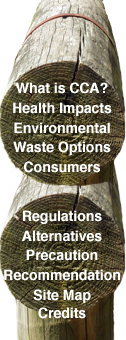Consumer Information
Introduction
A survey of hardware retailers, building industry information centres and treated timber industry representatives in Sydney was undertaken in November 2004 as a ‘snapshot’ of the level of information provided, to interested customers, on the precautions needed for using CCA-treated timber. The questions covered health and safety issues and environmental impacts, alternatives and sources for further information. The researcher posed as a potential customer. The responses to the seven questions are provided in the following table.
This survey raises many concerns for the level of information (and misinformation) that potential consumers of CCA-treated timber are receiving. Six of the 10 respondents recommended using CCA treated timber for children’s cubby houses, and 8 of the 9 respondents recommended using it for edging vegetable gardens. This confident recommendation contradicts many of the experimental research findings regarding CCA dislodging onto hands and leaching into soil, described previously in the sections on health and environmental impacts.
Six of the 9 respondents denied that arsenic posed a danger, with some respondents using very persuasive language and personal experience to prove this, stating there is ‘no proof in the world’ that it harms health (treated timber yard), ‘there’s no scientific evidence to prove it…I’ve worked with it every day for 25 years. I don’t worry about it. I mean, I don’t wash my hands before I eat my sandwich or anything’ (playset manufacturer), and ‘there’s no real proven truth yet that it does damage’ (timber company). One respondent even confronted the issue of arsenic by stating ‘there’s more arsenic in seafood and dairy’, and suggested that any timber treatment workers who have tested positive had ‘eaten prawns in the last 48 hours’. She then concluded that ‘there are no fully-fledged detrimental effects of CCA’ (timber treatment company). This statement is actually misleading, as naturally occurring arsenic in seafood is organic, rather than the inorganic variety used in timber preservation. In response to a question about safety precautions, the five respondents asked confirmed that it was safe for the general public to work with, and only when pushed recommended wearing safety equipment, such as gloves and mask.
When asked about alternative, non-arsenic based building materials for use in cubby houses and as garden edging, most respondents suggested Liquid Organic Solvent Preservative (LOSP). However, those staff actually working with the product dismissed it as a true alternative due to not being available for in-ground use; to not coming in logs suitable for edging or cubbies; and giving off nauseating fumes. It can also be up to 30 percent more expensive, as it is imported. Some other more feasible alternatives were mentioned, including wax-coating to seal in the CCA, using hardwood sealed with creosote, or even moving away from timber to cement or fibro sheeting.
Despite the expectation by industry representatives that there was free and available information for the general public about safe usage of CCA-treated timber, only one of the 5 retailers in the survey stocked pamphlets. Others directed the researcher to a website or the industry association telephone number, or displayed a poster, ‘Debate on CCA’. One retailer informed the researcher that they didn’t hold any pamphlets ‘because people know what they want’. None of the respondents suggested reading the Materials Safety Data Sheet for the CCA-treated products.
Additional advice on the dangers of CCA-treated timber was sought from the Poisons Information Centre, a recommended source of information on toxicity dangers for children. However, the spokesperson there dismissed any danger, stating ‘Don’t keep kids away from playgrounds with treated wood….the compound is impregnated into the wood and doesn’t come off…don’t worry [about negative media stories] because the media jump on the issue…’ (Poisons Information Centre spokesperson, (2004), Pers. Comm., 26/10/04).
In 2001 manufacturers in the US agreed to put warning labels on CCA-treated timber (see example) and provide consumer safety information sheets. The proposed labels for Australia are far less informative. According to Subbu Putcha at the APVMA, in the future timber will merely be branded with ‘Treated with Copper Chrome Arsenate’ (Putcha, S. APVMA, Pers. Comm., 21/12/04).


